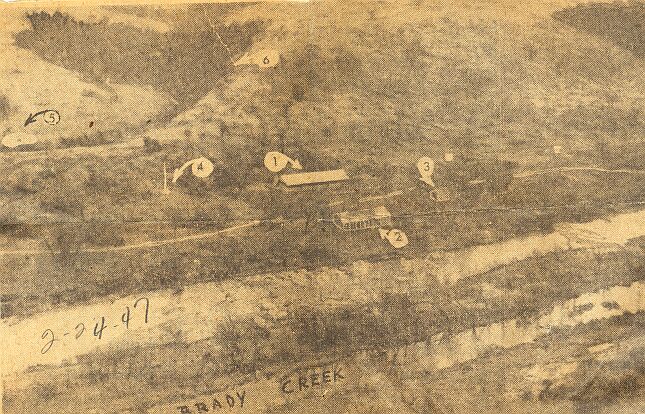 |
||
Old Camp Billy Gibbons1931
The first summer camp to be held on the Billy Gibbons ranch was in the summer of 1931. The camp fee was $5.50 per person. The Scouts had permission to hike and explore over the some 50,000 acre ranch. The camp was a tent camp with no permanent buildings of any kind. There was a brush arbor put up for the cooks to use in preparing meals, and there was a tent to eat in. Some 100 Scouts and leaders attended this camp. An old "Popping Johnny" gasoline engine and pump supplied water for the camp from Brady Creek. This first camp was under the leadership of O. E. Winebrenner, merit badge counselor; Bob Rankin, camp chairman; Cub Ragsdale, J. K. Wilkes, C. A. Meier, Tom Kellum, Roscoe Halliam, Henry Wilson, Hurch Stewatt, Cliff Pouncey, Dan Gill and Gaitha Browning of Brownwood; I. W. Phillips, Homer Tudor, Reece Jones, J. W. Heaton of Stephenville, Roy K. McCall, camp chaplain; Elvis Brown, Luster Morrison, Ed Fagg of San Saba; Rev. H. H. Dare, Bob Mayfield, R. L. Steen from Goldthwaite; Warren Taliaferro, Eric Matthews, Henry Ensters, W. A. Smith, Floyd Asher of Lampasas; J. E. Hansford, I. F. Harris, Joe Ashley from Blanket; Scout Executive H. B. Palmer of Uvalde, Chief Jim Red Eagle and Princes Inez from the Ruidoso Reservation. Two “professional cooks” were brought in from the Southwest Texas Council, probably the two cooks who had worked at Camp Fawcett that summer.
Runkles served as Scoutmaster of the troop, which was sponsored by the Dublin Baptist Church, in 1936 and 1937, at the age of 26 and 27. The charter for Troop 22 later was moved to Early, is still active, and sponsored by the Brownwood Kiwanis Club. John P. Kilgore, Brownwood, remembers serving on the so called Bull Gang that first year. The Bull Gang went down several days before camp opened to help set things up. One evening several of them were invited to Billy Gibbons’ home. It came a really hard rain. The San Saba River got up and they couldn't get back to camp. However, Kilgore remembers diving into the water and swimming across the river to get back to camp. The river was down the next morning and the other Scouts returned to camp. Archery at camp in 1934 with homemade
bows.
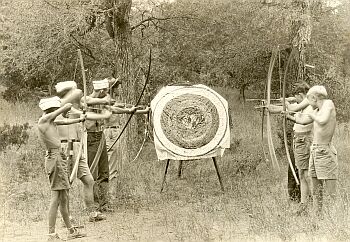 They had
campfires each night of camp, and Kilgore remembers
winning the liar's contest one night. He also
remembers the camp being a little bit
unorganized. The Scouts themselves put on the
program. They had
campfires each night of camp, and Kilgore remembers
winning the liar's contest one night. He also
remembers the camp being a little bit
unorganized. The Scouts themselves put on the
program.
Uncle Billy Gibbons, as he was affectionately known to the Scouts, visited the camp several times while they were in session. Later, he said that he would give a free 99 year lease for this spot for a summer camp area to the then Pecan Valley Council. The camp used an old truck to drive into town each day to get bread and ice. It took two hours to drive the some twelve miles to town. According to J. Arthur Thomason, the staff members that went into town with the truck found it was easier to walk along side the truck than in it because the ride was so rough.
The Bugle
Call newspaper was published for the first
time. Guy Quirl, who was now the Scout
Executive of the newly organized Comanche Trail
Council, brought the idea of the daily camp
newspaper with him from Camp Martin. In fact,
the first issue used “Volume V,” the first four
volumes having been published at Camp Martin.
Wayne C. Sellers was the Editor and Homer Tudor was
the Art Editor. The sponsor was E. E. Lennon.
The old swimming hole in 1934....
......
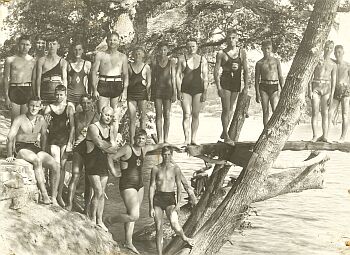 The camp ran from
July 19 to the 26. They had 224 Scouts and 33
leaders from twenty troops participate in the second
year at Camp Billy Gibbons. Two trained nurses
were provided to the camp courtesy of the Central
Texas Hospital of Brownwood and were located in a
First Aid tent by the site of the Headquarter's
tent. Troops 17 and 18 were in camp with their
band and provided music during the week. The camp ran from
July 19 to the 26. They had 224 Scouts and 33
leaders from twenty troops participate in the second
year at Camp Billy Gibbons. Two trained nurses
were provided to the camp courtesy of the Central
Texas Hospital of Brownwood and were located in a
First Aid tent by the site of the Headquarter's
tent. Troops 17 and 18 were in camp with their
band and provided music during the week.
Everyone was requested to get a rock and deposit it in a stack by the flag pole for the purpose of building a memorial to “Uncle Billy Gibbons,” who had passed away earlier that spring. Sunday was visitor’s day and a special memorial service was held at 2:30 p.m. for Billy Gibbons. During the service, each leader and scout in camp filed by a spot on the camp grounds and placed a native stone taken from the ranch. While the scout band played “Onward Christian Soldiers” three Eagle Scouts, Lloyd Smith, Louis Winebrenner and Herman Britt, placed a floral wreath on the rocks. Judge Baker of San Saba and a friend of Billy Gibbons, made the principle talk. The service was closed with everyone facing west, Scouts at attention, while “Taps” was played. Eagle Scouts later built a memorial to Gibbons. The memorial was a flag pole with a nice rock base. When the camp was moved to the current Camp Billy Gibbons, the same kind of flag pole and base was built there.
Camp Flooded During the
summer camp of 1938 a big flood hit the camp.
It was just at the end of the first week of camp,
with another week to follow, when a head rise of
several feet of water came down Brady Creek.
It all started when one of the Scouts told Guy
Quirl, the Camp Director, and said the creek is
rising. Flood in 1938 At Old Camp Billy Gibbons
Camp Destroyed In
1945 The camp was destroyed in 1945 by the new land owners after Billy Gibbons died. They did not want the camp there so bulldozed all the trees off the twenty-five acre plot. They were taken to court and settled for $12,500.
A story in the Brownwood Bulletin, February 24, 1947, stated: "DENUDED CAMP BILLY GIBBONS - The aerial photo above shows Camp Billy Gibbons, summer wilderness Boy Scout camp of the Comanche Trail Council on the banks of Brady Creek in San Saba County, after the campsite was stripped of most of its trees. Jake L. Hamon, Dallas oil man, is the owner of the property. The Council holds a 25-year lease on the campsite. The Council executive committee has asked $25,000 from Hamon to build a camp on another site. Hamon is to give his answer here on Sunday, March 2. Shown in the picture are: (1) Mess Hall; (2) canteen and pavilion; (3) First Aid Building; (4) Uncle Billy Gibbons Memorial Flag base and pole; (5) Council ring; (6) Ku-Ni-Eh Draw and wooded section. Before the mass destruction of the trees, the entire area from the air resembled the wooded section of Ku-Ni-Eh Draw. Most of the trees left standing have been dug around at the roots so that they will die. Brady Creek is shown in the foreground with the slough between the main bed of the creek and the camping area. - (Bulletin Staff Photo from Willis Aviation Plane)." A settlement was then made with Jake Hamon for the council to surrender the remainder of the 25-year lease in exchange for Hamon paying the council $12,500. The council kept the right to salvage material from the old Camp Billy Gibbons for use in building the new camp. | Photos of the "Old" Camp Billy Gibbons | More Photos of "Old" Camp Billy Gibbons | Jim White, Brownwood High School Class of 1947, was able in 1999 to get a group of his classmates to write their memories of Camp Billy Gibbons. These memories were edited by White and printed in The Roar of '47, the Brownwood High School Class of 1947 newsletter. He noted "White there may be (and certainly are) inaccuracies/inconsistencies in each and every story, they are published as written. After all, one cannot expect memory of over 50 years to be 'chiseled in stone.' The main feature through all of these stories, however, is the clear picture that is painted of the fondness of that place and time. Thanks guys for contributing your memories - Jim White. We present them below. Photos were added to enhance those memories. | Alan Burton | Lloyd Corder | George Day | John Chaney | Bobby Reese | Pat Weekley | Frank Wells | Jim White | Click below for some more memories of Old Camp Billy Gibbons | Troop Photos | | Lease Agreement
| The
How, Why and When of Camp Billy Gibbons by
Cliff Pouncey l | The Story of Camp Billy Gibbons by E. B. Henley | Just Over the Hill by Phillip Pegues | | The Bugle Call Newspaper | Anecdotes by John E. Davis | Radio Talk Show | Bill Philpott Memories | | "I Remember - Old and New Camp Billy Gibbons" by John M. Arthur | | Mays Ranching Company, Inc., owners of the Billy Gibbons Ranch and the Ranch History | Information for this page taken from The Camp Billy Gibbons Story by Guy N. Quirl and Eldon Sehnert, 1989, and Ninety Years of Service - A History of Comanche Trail Council 1910 - 1999, by Frank T. Hilton, 1999. Photos from the archives of the Comanche Trail Council, BSA. Last
updated: September 13, 2020 |
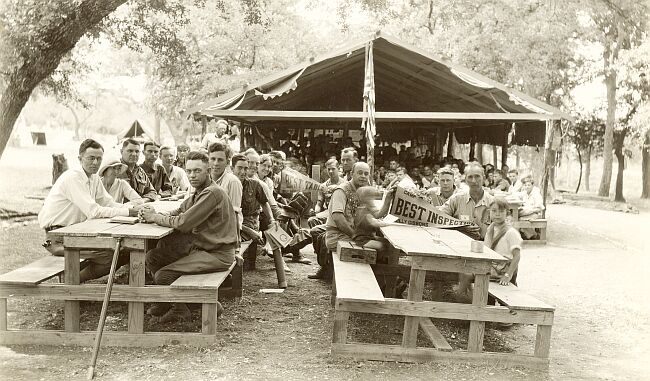
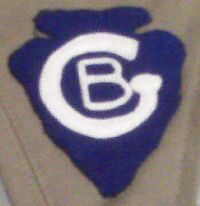 This is a photo
of the first Camp Billy Gibbons felt patch. It
was used in the early to mid 1930's This
patch, shown here, is now located in the South
Plains Council museum, Lubbock, TX, on the merit
badge sash of the father of OA Lodge 150. It
belonged to Frank A. "Chief" Runkles, an adult who
was formerly a Scoutmaster in the Comanche Trail
Council, BSA, in Troop 22 of Dublin.
This is a photo
of the first Camp Billy Gibbons felt patch. It
was used in the early to mid 1930's This
patch, shown here, is now located in the South
Plains Council museum, Lubbock, TX, on the merit
badge sash of the father of OA Lodge 150. It
belonged to Frank A. "Chief" Runkles, an adult who
was formerly a Scoutmaster in the Comanche Trail
Council, BSA, in Troop 22 of Dublin. 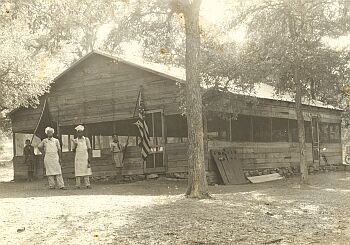 A dining hall was added to the camp.
The Council decided that the dining hall that
belonged to the old Oil Belt Council, located on the
Llano River at then Camp Martin, could be moved to
the new camp site on Brady Creek. It was quite
an ordeal. They took drawing pens and marked
all the boards on the south side of the building
with an "S," on the east with an "E," etc., until
all four sides were marked. Moving trucks were
loaded with the timber, and when they arrived at the
Brady Creek site they unloaded the lumber and
rebuilt the building easily. This first dining
hall was a wooden structure with a tin roof and a
screen band around the middle of the wall.
Gravel was used for the floor.
A dining hall was added to the camp.
The Council decided that the dining hall that
belonged to the old Oil Belt Council, located on the
Llano River at then Camp Martin, could be moved to
the new camp site on Brady Creek. It was quite
an ordeal. They took drawing pens and marked
all the boards on the south side of the building
with an "S," on the east with an "E," etc., until
all four sides were marked. Moving trucks were
loaded with the timber, and when they arrived at the
Brady Creek site they unloaded the lumber and
rebuilt the building easily. This first dining
hall was a wooden structure with a tin roof and a
screen band around the middle of the wall.
Gravel was used for the floor. 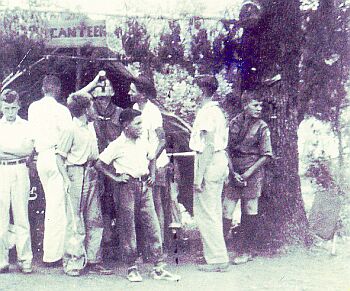 Camp
Canteen
Camp
Canteen
